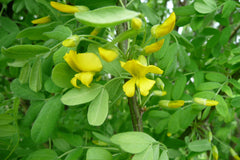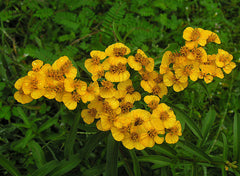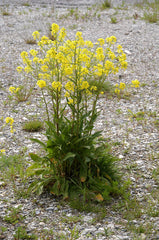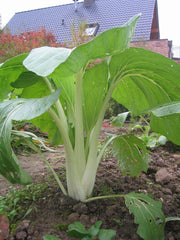Rumex acetosa, Sorrel - Sorrel de Belleville (large leaved)
Sorrel has been used since ancient times as a food and medicinal plant. It is still cultivated for its edible leaves. The plant stops producing leaves when it flowers in the summer, regrowing after the seed has set. Plants also usually die down in the winter. Cutting down the flowering stem will encourage the growth of fresh young leaves.
A food plant for the caterpillars of many species of butterfly, it is a good plant to grow in the spring meadow.
Dioecious. Male and female plants must be grown if seed is required.
Height 40-80cm. Young leaves have a tangy taste used to liven up salads. Used for salads, also as a vegetable like Spinach.
Dark green to brown and dark grey dyes can be obtained from the roots, they do not need a mordant.
A grey-blue dye is obtained from the leaves and stems.
The juice of the plant removes stains from linen and also ink stains (but not ball-point ink) from white material.
A very easily grown and tolerant plant, it succeeds in most soils, preferring a moist moderately fertile well-drained soil in a sunny position. Shade tolerant. Established plants are tolerant of considerable neglect, surviving even in dense weed growth.
Sow spring in situ. Leaves can be harvested within 8 weeks from sowing.
Division in spring. Division is very simple at almost any time of the year, though the plants establish more rapidly in the spring. Use a sharp spade or knife to divide the rootstock, ensuring that there is at least one growth bud on each section of root.
Edible uses:
Leaves - raw or cooked. They make a thirst-quenching on their own, or can be added to salads, used as a potherb or pureed and used in soups. A delicious lemon-like flavour, liked by most people who try them, they can be rather overpowering in quantity and are more generally used as a flavouring in mixed salads. The leaves can also be dried for later use. The leaves can be available all through the winter, especially in mild weather or if a little protection is given to the plants.
The leaves should be used sparingly in the diet, they can contain quite high levels of oxalic acid, which is what gives the leaves of many members of this genus an acid-lemon flavour. Perfectly alright in small quantities, the leaves should not be eaten in large amounts since the oxalic acid can lock-up other nutrients in the food, especially calcium, thus causing mineral deficiencies. The oxalic acid content will be reduced if the plant is cooked. People with a tendency to rheumatism, arthritis, gout, kidney stones or hyperacidity should take especial caution if including this plant in their diet since it can aggravate their condition.
Flowers - cooked as a vegetable or used as a garnish.
Root - cooked. It is dried, ground into a powder and made into noodles.
Seed - raw or cooked. Ground into a powder and mixed with other flours to make bread. The seed is easy to harvest, but is rather small and fiddly to use.
The juice of the leaves can be used as a curdling agent for milks.




![Photo By Thomas888b (Own work) [CC BY-SA 3.0 (http://creativecommons.org/licenses/by-sa/3.0) or GFDL (http://www.gnu.org/copyleft/fdl.html)], via Wikimedia Commons](http://www.openpollinated.co.uk/cdn/shop/products/Calendula_in_Autumn_medium.jpg?v=1510586850)


![By Evan-Amos (Own work) [Public domain], via Wikimedia Commons](http://www.openpollinated.co.uk/cdn/shop/products/CSA-Red-Spring-Onions_medium.jpg?v=1510586802)
